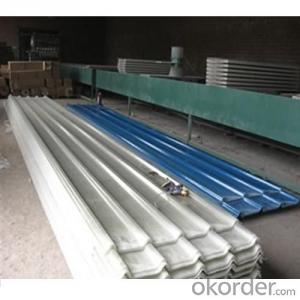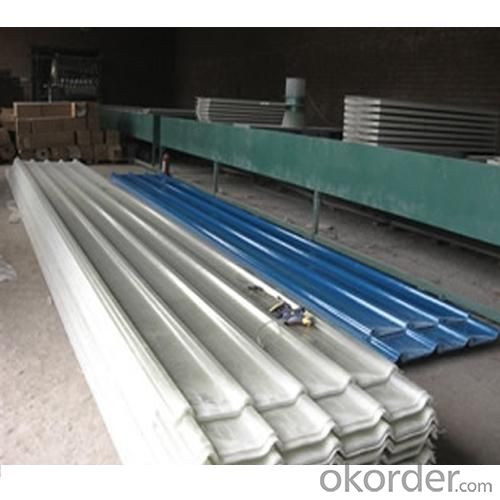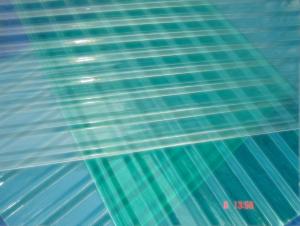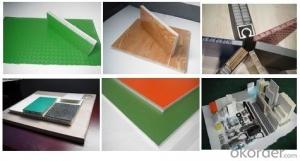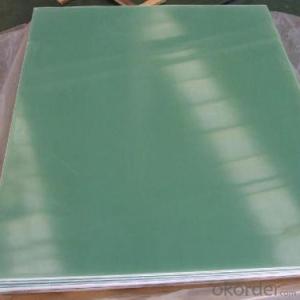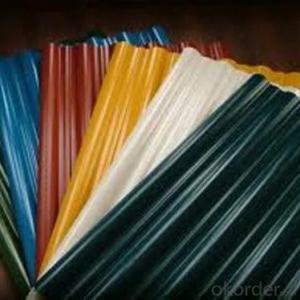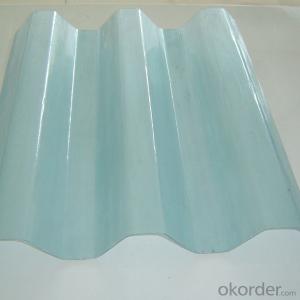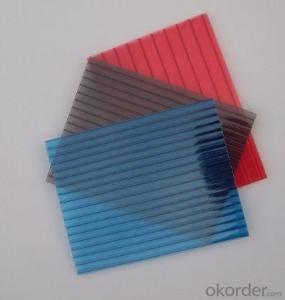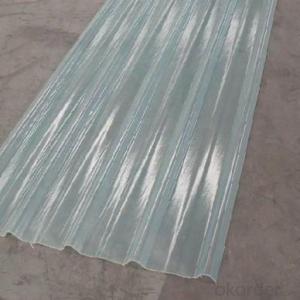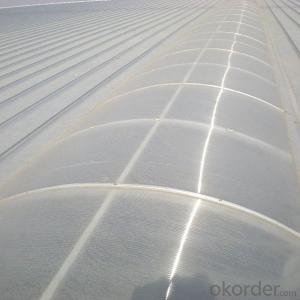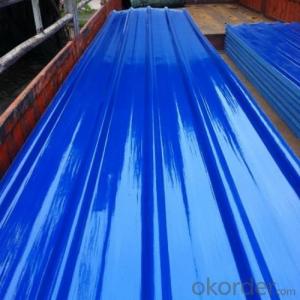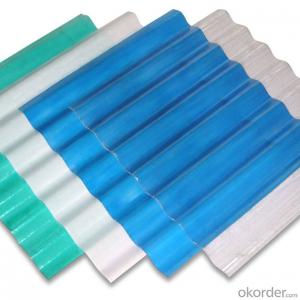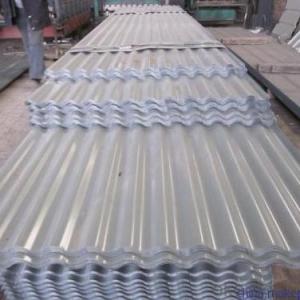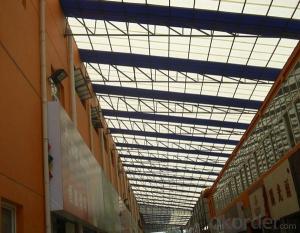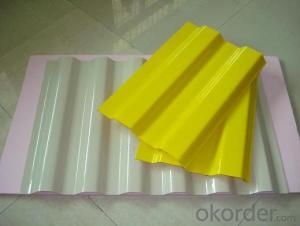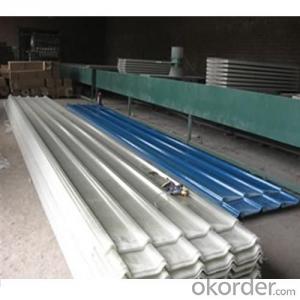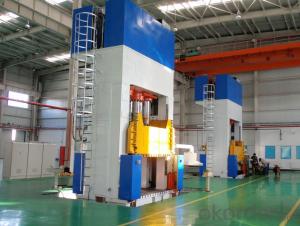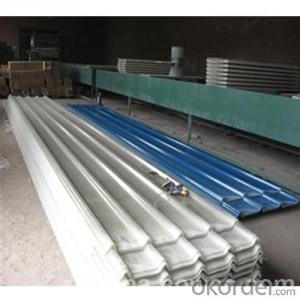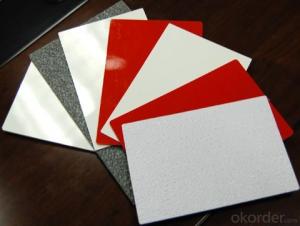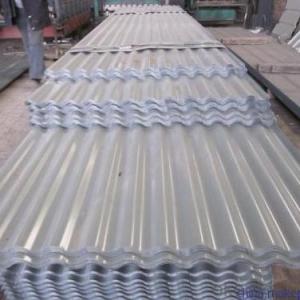FRP Roofing Panel - Fiberglass Panels for Diverse Applications
- Loading Port:
- Shanghai
- Payment Terms:
- TT or LC
- Min Order Qty:
- 20000 kg
- Supply Capability:
- 200000 kg/month
OKorder Service Pledge
OKorder Financial Service
You Might Also Like
Brief Introduction
the FRP anti-corrosion panel are produced in the same production line with FRP skylight panel, it has greater and more requirements of the professional technology. There are only a few of the manufacturers who can produce FRP opaque panels in China. A lot of FRP opaque corrugated panels have quality problems after intalled. Higoal is a mature manufacturer in producing FRP opaque corrugated panel (anti-corrosion panel), and has great advantages in both quality and lower cost.
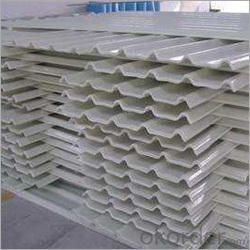
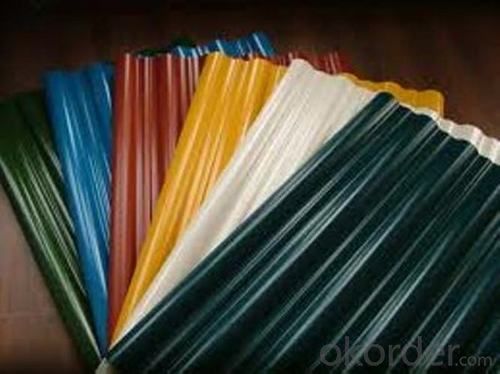
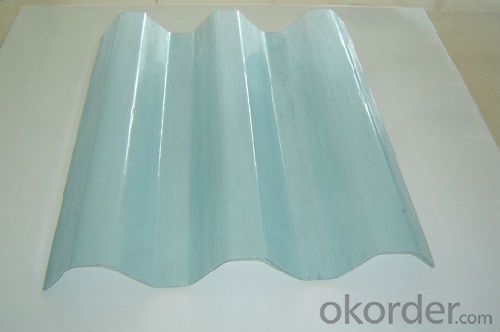
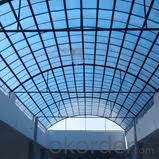
Characteristics
Mechanical properties: high rigidity lighting panels
Plate matches: match with general prepainted galvanized sheet, galvanized steel
Resin composites: Improved anti-aging SMR198 resin
Fiber reinforcement: E-glass fiber untwisted without glue
Surface treatment: affixing MELINEX301 film
Stiffener line: surface with longitudinal uniform distribution of anti-LAC gluten
Technical Specification
Glass fiber: not less than 28%
Unit Weight: 1800g / ㎡, 2400g / ㎡, 3050g / ㎡
Nominal thickness: 1.2 mm, 1.5mm, 2.0mm (tolerance ≤ 10%)
Temperature limits: -60 ℃ ~ +130 ℃
Transmittance (1.5mm): 72% ± 2% (fog white, sky blue, water green), 52% ± 2% (white porcelain)
UV-rate: 99%
Tensile strength: 90Mpa
Flexural strength: 160 Mpa
Elongation: 1.9%
Pap hardness: ≥ 50
Thermal expansion coefficient: 1.5 ~ 3.2 * 10-5 / K
Thermal conductivity: K = 0.23W / m * K
Guarantee: 15 years
NOTE: In special cases, the surface film varieties vary according to needs, such as Melinex389, PT055 and so on.
FAQ
Better property of corrosion resistant than clading panel and stainless steel, it was designed for the harsh conditions, which require products that can withstand corrosive chemicals, high temperature.
- Q: Do FRP roofing panels have any specific load-bearing capacity?
- FRP roofing panels possess a distinct load-bearing capacity. Several factors influence the load-bearing capacity of FRP roofing panels, including the material's thickness and composition, the panels' design and installation, and the intended application and purpose of the panels. FRP roofing panels are engineered to endure a specific amount of weight or load without undergoing deformation or structural failure. Manufacturers or relevant industry standards typically determine the load-bearing capacity of FRP roofing panels through comprehensive testing and evaluation. These assessments evaluate the panels' ability to resist various types of loads, encompassing static loads like the panels' own weight or the accumulation of snow or ice, as well as dynamic loads like wind or seismic forces. It is worth noting that the load-bearing capacity of FRP roofing panels can differ based on the specific model or brand. Hence, it is crucial to refer to the manufacturer's technical specifications or guidelines to ascertain the precise load-bearing capacity of the panels employed in a particular project. Moreover, it is advisable to enlist the expertise of a certified structural engineer or roofing professional who can evaluate the project's specific requirements and guarantee that the load-bearing capacity of the FRP roofing panels is suitable for the intended application. By taking these precautions, the safety and durability of the roofing system can be ensured.
- Q: Are FRP roofing panels resistant to bird nesting or infestations?
- Generally, FRP roofing panels exhibit resistance to bird nesting and infestations. The sleek surface of these panels poses challenges for birds in their search for suitable nesting spots. Furthermore, the material is not easily penetrable, preventing birds from forming holes or gaining access to the roof's interior. Nevertheless, it is worth mentioning that although FRP panels are resistant to bird infestations, they are not entirely impervious. Birds that are persistent or determined may still endeavor to construct nests on or around the panels. However, overall, FRP roofing panels prove effective in deterring bird nesting and infestations.
- Q: Are FRP roofing panels resistant to damage from high temperatures?
- Yes, FRP roofing panels are highly resistant to damage from high temperatures. FRP stands for Fiberglass Reinforced Plastic, which is a composite material that is specifically designed to withstand extreme temperature conditions. These panels are manufactured using a combination of fiberglass and resin, which gives them excellent thermal stability and resistance to heat. FRP roofing panels have a high melting point and do not warp, crack, or deteriorate when exposed to high temperatures. They are commonly used in industrial and commercial settings where there is a need for heat resistance, such as factories, warehouses, and chemical plants. Overall, FRP roofing panels are a reliable and durable choice for protecting structures from heat-related damage.
- Q: Can FRP roofing panels be used in curved or domed roofs?
- Yes, FRP (Fiberglass Reinforced Plastic) roofing panels can be used in curved or domed roofs. FRP panels are flexible and can be easily molded or shaped to fit various roof designs, including curved or domed structures. The flexibility of FRP allows it to be bent or curved without compromising its structural integrity. This makes FRP roofing panels a suitable choice for architectural designs that require curved or domed roofs. Additionally, FRP panels offer excellent durability, weather resistance, and UV protection, making them a reliable option for a wide range of roofing applications.
- Q: Can FRP roofing panels be used in high-temperature environments?
- Certainly! FRP roofing panels are capable of being utilized in environments with high temperatures. Their design is specifically engineered to endure a wide range of temperatures, making them commonly employed in industries where elevated temperatures are prevalent, such as chemical processing plants, power plants, and industrial manufacturing facilities. A significant advantage of FRP roofing panels lies in their remarkable resistance to heat. They can endure temperatures of up to 200 degrees Celsius (392 degrees Fahrenheit) without experiencing warping, melting, or deformation. This characteristic renders them ideal for use in environments where high temperatures pose a concern. Moreover, FRP panels possess low thermal conductivity, meaning they do not easily transfer heat. This quality aids in maintaining a stable temperature within the structure, providing insulation against extreme heat. It also contributes to energy efficiency by reducing the necessity for supplementary cooling systems. In addition to their heat resistance, FRP roofing panels offer a multitude of other advantages. They are lightweight, durable, and boast a lengthy lifespan, making them a cost-effective choice for high-temperature environments. Additionally, they possess corrosion-resistant and UV-stable properties, ensuring their ability to withstand harsh weather conditions and prolonged exposure to sunlight. Nevertheless, it is crucial to note that the specific temperature limitations for FRP panels may vary depending on the manufacturer and the specific product. Consequently, consulting the manufacturer's guidelines and specifications is imperative to ensure that the FRP roofing panels are suitable for the intended high-temperature environment.
- Q: Are FRP roofing panels suitable for animal shelters or kennels?
- Yes, FRP roofing panels are suitable for animal shelters or kennels. FRP panels offer several advantages such as durability, resistance to corrosion, easy installation, and low maintenance. Additionally, they are waterproof, which is crucial to protect animals from rain and other weather elements. The panels also provide good insulation, ensuring a comfortable environment for the animals. Overall, FRP roofing panels are an excellent choice for animal shelters or kennels due to their durability and practicality.
- Q: Can FRP roofing panels be used for skylights in museums?
- Skylights in museums can utilize FRP (Fiberglass Reinforced Plastic) roofing panels. These panels possess lightweight, durable attributes and exceptional light transmission properties, making them well-suited for skylight purposes. By allowing natural light to illuminate museum spaces, the reliance on artificial lighting can be reduced, resulting in a more visually appealing environment for visitors. Moreover, FRP panels are resistant to UV radiation and can be manufactured with various coatings and finishes to regulate light transmission, glare, and heat gain. Thus, the skylight panels can meet the specific requirements of the museum, protecting delicate artwork or artifacts from excessive light exposure. Ultimately, FRP roofing panels provide an efficient and visually pleasing solution for skylights in museums.
- Q: Are FRP roofing panels prone to warping from heavy machinery?
- The durability and resistance to warping of FRP roofing panels are well-known. However, exposure to heavy machinery may result in warping, depending on various factors. To begin with, the resistance to warping of FRP roofing panels is greatly influenced by their thickness and quality. Thicker panels with a higher fiberglass content are less likely to warp under heavy machinery loads compared to thinner or lower-quality panels. Additionally, the type and weight of the heavy machinery can affect the probability of warping. While FRP panels can withstand normal loads like snow or wind, excessive weight from heavy machinery can surpass their load-bearing capacity and potentially cause warping. Moreover, the condition of the underlying support structure is crucial. If the structure is weak or incapable of handling the weight of heavy machinery, it can create localized pressure points on the FRP panels, increasing the risk of warping. Proper installation is also vital in preventing warping. Inadequate fastening of the panels or gaps and uneven pressure distribution during installation can contribute to warping, particularly under heavy machinery loads. To minimize the possibility of warping, it is advisable to seek guidance from a professional roofing contractor with expertise in FRP installations. They can evaluate the specific requirements of the roofing project, taking into account the type and weight of machinery involved, and recommend suitable panel thickness, quality, and installation techniques to ensure maximum durability while minimizing the risk of warping.
- Q: Can FRP roofing panels be used in schools or educational institutions?
- Yes, FRP roofing panels can be used in schools or educational institutions. FRP (Fiber Reinforced Plastic) roofing panels are lightweight, durable, and resistant to corrosion, making them suitable for various applications, including educational buildings. They offer excellent weather protection, insulation, and can be easily installed or replaced, making them a cost-effective choice for schools. Additionally, FRP panels are available in various colors and designs, allowing for customization to match the aesthetic requirements of educational institutions.
- Q: Do FRP roofing panels come in different colors?
- FRP roofing panels do indeed come in various colors. Although the most popular choice is a translucent or clear shade, there is also a wide array of other options including white, green, blue, red, and more. This provides greater flexibility in design and enhances the visual appeal of different construction projects. Furthermore, certain manufacturers offer customization features, enabling customers to choose specific colors that align with their preferences or project needs.
Send your message to us
FRP Roofing Panel - Fiberglass Panels for Diverse Applications
- Loading Port:
- Shanghai
- Payment Terms:
- TT or LC
- Min Order Qty:
- 20000 kg
- Supply Capability:
- 200000 kg/month
OKorder Service Pledge
OKorder Financial Service
Similar products
Hot products
Hot Searches
Related keywords
